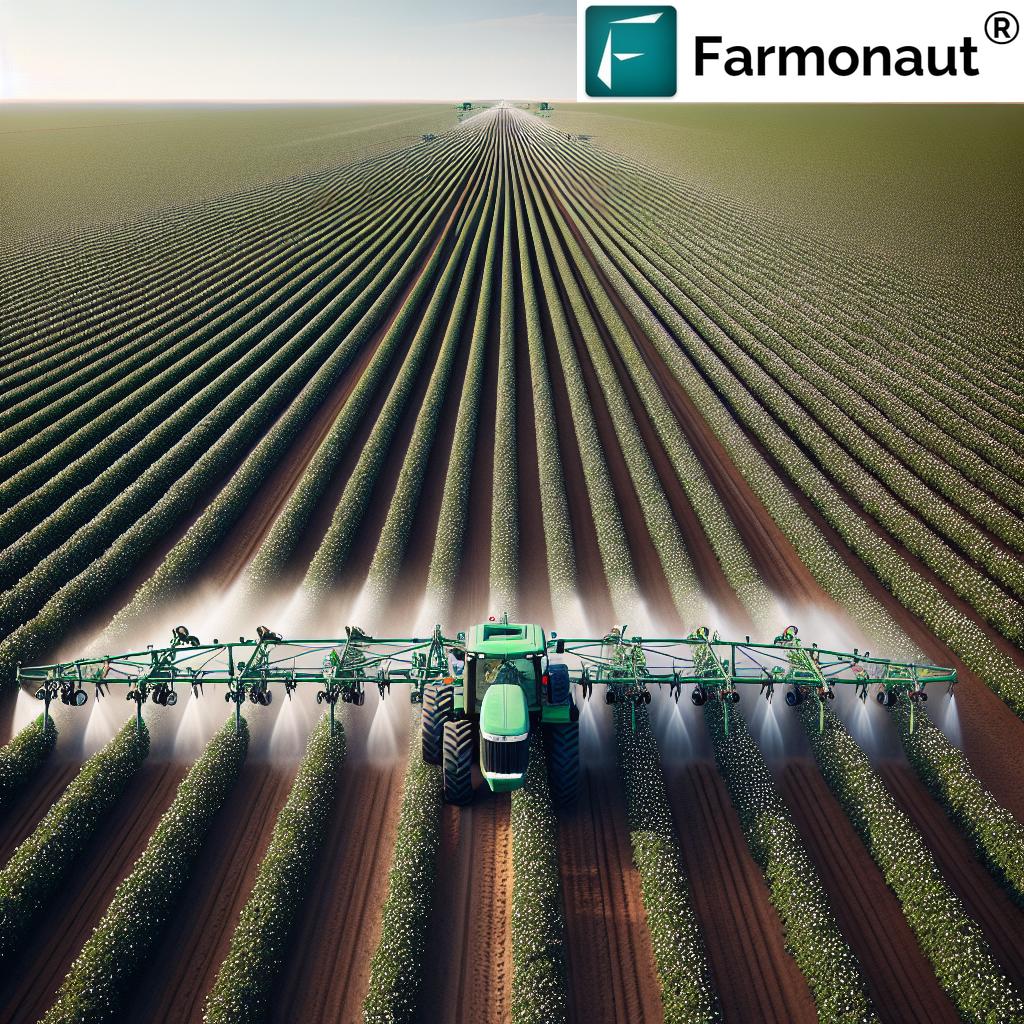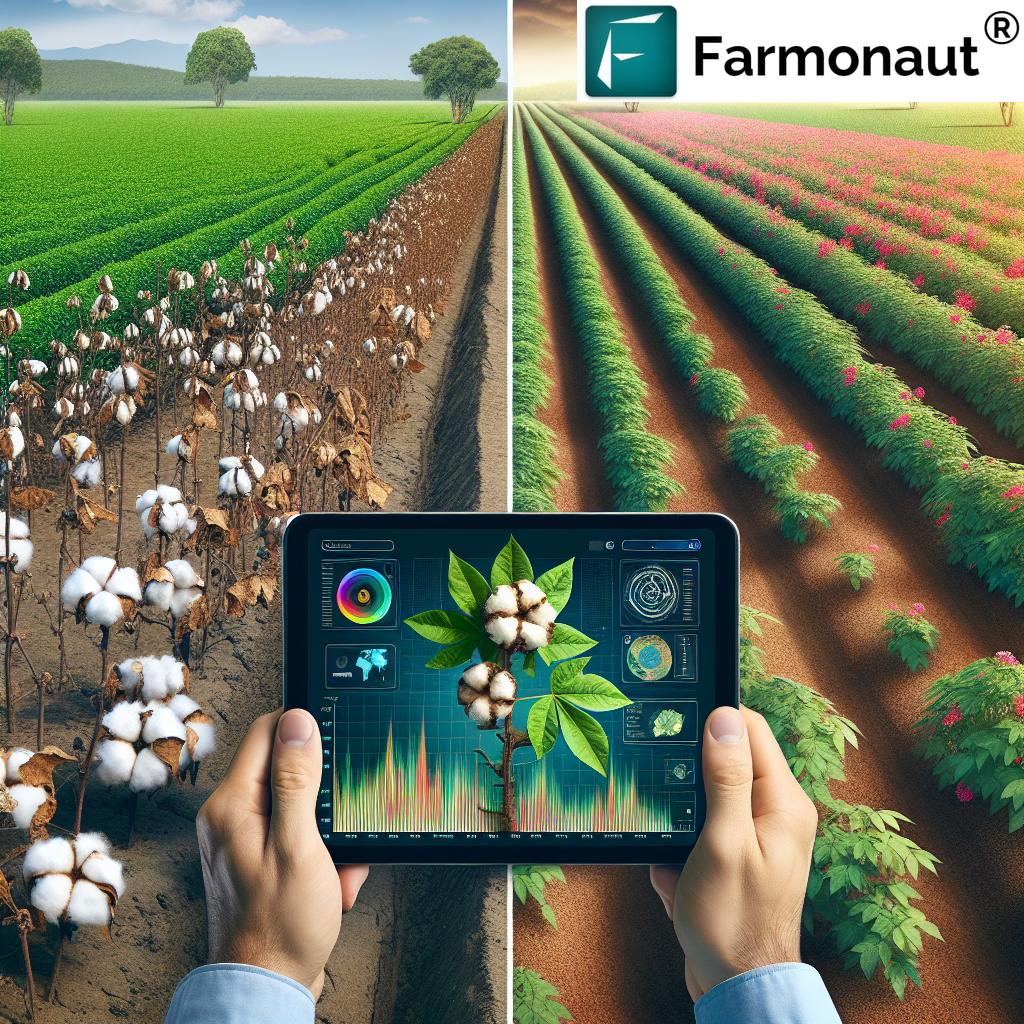Cotton Industry Trends 2024: Texas High Plains Growers Leverage Precision Agriculture for Sustainable Production
“Texas High Plains cotton growers increased sustainable production by 30% in 2023 through precision agriculture techniques.”

As we delve into the cotton industry trends of 2024, we’re witnessing a remarkable transformation in the Texas High Plains. The convergence of sustainable cotton production and cutting-edge agricultural technology for cotton is reshaping the landscape of this vital sector. In this comprehensive report, we’ll explore how high plains cotton growers are leveraging precision agriculture in cotton farming to drive productivity, sustainability, and economic growth.
The Evolution of Cotton Crop Management
The cotton industry has come a long way from traditional farming methods. Today, cotton crop management is a sophisticated process that integrates advanced technologies, data analytics, and sustainable practices. Let’s examine the key factors driving this evolution:
- Adoption of satellite-based monitoring systems
- Implementation of AI-driven decision support tools
- Integration of IoT devices for real-time field data collection
- Utilization of blockchain for supply chain transparency
These advancements have revolutionized how we approach cotton cultivation, enabling farmers to make data-driven decisions that optimize yield while minimizing environmental impact.
The video above demonstrates the power of mapping technologies in various crop productions, including cotton. This level of precision is now being applied across the Texas High Plains, transforming the way we monitor and manage cotton fields.
Precision Agriculture: A Game-Changer for Cotton Farmers
Precision agriculture in cotton farming has emerged as a cornerstone of modern cultivation practices. By leveraging advanced technologies, farmers can now:
- Optimize irrigation schedules based on real-time soil moisture data
- Apply fertilizers and pesticides with pinpoint accuracy
- Predict and mitigate pest outbreaks before they become widespread
- Forecast yields with greater accuracy for better market planning
These capabilities not only enhance cotton farm productivity but also contribute significantly to sustainable cotton production. As we move further into 2024, we anticipate even greater adoption of these technologies across the Texas High Plains.
Farmonaut, a leading provider of agricultural technology solutions, offers powerful tools for cotton farmers looking to embrace precision agriculture. Their satellite-based crop health monitoring system and AI-driven advisory services are particularly valuable for optimizing cotton production.
Legislative Advocacy and Industry Support
The success of the cotton industry in the Texas High Plains is not solely due to technological advancements. Strong cotton industry legislation and advocacy play crucial roles in supporting growers and promoting sustainable practices. Key areas of focus include:
- Farm Bill implementation and refinement
- Trade agreements that benefit U.S. cotton producers
- Crop insurance programs tailored to the unique needs of cotton farmers
- Conservation initiatives that align with sustainable production goals
We continue to work closely with legislators and industry organizations to ensure that the interests of cotton producers are well-represented at both state and national levels.
Cotton Market Analysis: Trends and Projections
Understanding the global cotton market is crucial for Texas High Plains growers to make informed decisions. Our cotton market analysis for 2024 reveals several key trends:
- Increasing demand for sustainable and traceable cotton
- Growing competition from synthetic fibers
- Shifts in global trade patterns due to geopolitical factors
- Rising interest in organic and specialty cotton varieties
These trends underscore the importance of adaptability and innovation in the cotton industry. By leveraging precision agriculture and sustainable practices, Texas High Plains growers are well-positioned to meet evolving market demands.
The video above showcases how advanced technologies like those offered by Farmonaut can be used for accurate crop area estimation, a critical component of market analysis and production planning in the cotton industry.
“Advanced remote sensing technologies improved cotton yield predictions by 25% for farmers using Farmonaut’s GIS tools.”
Sustainable Cotton Production: A Priority for 2024
Sustainable cotton production is no longer just a buzzword; it’s a necessity for the long-term viability of the industry. Texas High Plains growers are at the forefront of implementing sustainable practices, including:
- Water conservation techniques
- Integrated pest management systems
- Soil health improvement programs
- Energy-efficient farming equipment
These efforts not only reduce the environmental footprint of cotton production but also often lead to cost savings and improved crop quality. The adoption of sustainable practices is supported by ongoing cotton research and development initiatives, many of which are conducted in partnership with agricultural extension programs and universities.
Farmonaut’s API and API Developer Docs provide valuable resources for integrating sustainable farming practices with cutting-edge technology.
The Role of Agricultural Extension and Universities
Agricultural extension programs and universities play a vital role in advancing cotton research and development. These institutions:
- Conduct field trials of new cotton varieties
- Develop and test innovative farming techniques
- Provide educational resources to cotton growers
- Facilitate knowledge transfer between researchers and farmers
The collaboration between academia, industry, and growers is essential for driving innovation and ensuring that the latest advancements in cotton production are effectively implemented in the field.

Enhancing Farm Productivity Through Technology
Improving cotton farm productivity is a top priority for Texas High Plains growers. The integration of advanced technologies is key to achieving this goal. Some of the most impactful technologies include:
- GPS-guided precision planting systems
- Drone-based crop monitoring and spraying
- Variable rate irrigation systems
- Automated harvesting equipment
These technologies not only increase efficiency but also help in reducing labor costs and minimizing resource waste. Farmonaut’s suite of tools, including their mobile apps, are designed to support farmers in implementing these productivity-enhancing technologies.
The video above illustrates how satellite data, a key component of Farmonaut’s technology, is revolutionizing farming practices, including those in the cotton industry.
Addressing Global Economic Challenges
The cotton industry, like many others, faces significant global economic challenges. These include:
- Trade tensions and shifting international markets
- Fluctuating commodity prices
- Increasing production costs
- Climate change impacts on crop yields
To navigate these challenges, Texas High Plains cotton growers are focusing on:
- Diversifying market opportunities
- Implementing risk management strategies
- Investing in technologies that improve resilience
- Collaborating with industry partners to strengthen the supply chain
By addressing these challenges head-on, the cotton industry in the Texas High Plains is positioning itself for long-term success and sustainability.
The Future of Cotton Production: AI and Machine Learning
As we look to the future of cotton production, artificial intelligence (AI) and machine learning are poised to play increasingly important roles. These technologies offer tremendous potential for:
- Predictive analytics for pest and disease management
- Automated crop health assessments
- Optimized resource allocation based on historical and real-time data
- Enhanced decision-making support for farmers
The video above provides insights into the role of AI in agriculture, highlighting its potential to transform cotton farming practices in the coming years.
Cotton Production Trends in Texas High Plains (2023-2024)
| Production Metric | 2023 Value | 2024 Projected Value | Percent Change |
|---|---|---|---|
| Total Acreage Planted | 4.5 million acres | 4.7 million acres | +4.4% |
| Average Yield (lbs/acre) | 750 lbs/acre | 785 lbs/acre | +4.7% |
| Precision Agriculture Adoption Rate | 60% | 75% | +25% |
| Water Usage Efficiency | 0.85 bales/acre-inch | 0.92 bales/acre-inch | +8.2% |
| Pesticide Application Rate | 2.5 lbs/acre | 2.2 lbs/acre | -12% |
| Sustainable Practices Implementation | 70% | 85% | +21.4% |
| Economic Impact ($ millions) | $6,200 | $6,800 | +9.7% |
Conclusion: Embracing Innovation for a Sustainable Future
As we’ve explored throughout this comprehensive report, the cotton industry in the Texas High Plains is undergoing a significant transformation. By embracing precision agriculture in cotton farming, implementing sustainable practices, and leveraging cutting-edge technologies, growers are positioning themselves for success in an increasingly competitive global market.
The challenges ahead are substantial, but so are the opportunities. With continued investment in research and development, strong legislative support, and a commitment to innovation, we’re confident that the Texas High Plains will remain a leader in sustainable cotton production for years to come.
As we move forward, it’s crucial that we continue to foster collaboration between farmers, researchers, technology providers, and policymakers. Together, we can ensure that the cotton industry not only survives but thrives in the face of global challenges.
For those looking to stay at the forefront of these advancements, Farmonaut offers a range of tools and services designed specifically for the cotton industry. Explore their offerings to see how you can leverage the power of satellite technology and AI to optimize your cotton production.
Frequently Asked Questions
Q: How is precision agriculture improving cotton farming in the Texas High Plains?
A: Precision agriculture is enhancing cotton farming through satellite-based monitoring, AI-driven decision support, and targeted resource application, leading to improved yields and sustainability.
Q: What role does sustainable production play in the future of the cotton industry?
A: Sustainable production is crucial for long-term viability, addressing environmental concerns, meeting consumer demands, and ensuring the economic stability of cotton farming communities.
Q: How are cotton growers adapting to global economic challenges?
A: Growers are diversifying markets, implementing risk management strategies, investing in resilience-enhancing technologies, and strengthening industry collaborations to navigate economic uncertainties.
Q: What advancements in cotton research are most promising for the industry?
A: Key advancements include drought-resistant cotton varieties, AI-powered pest management systems, and innovative water conservation techniques developed through university and industry partnerships.
Q: How can small-scale cotton farmers benefit from the latest agricultural technologies?
A: Small-scale farmers can leverage affordable precision agriculture tools, such as Farmonaut’s satellite-based monitoring system, to optimize their operations and compete more effectively in the market.






